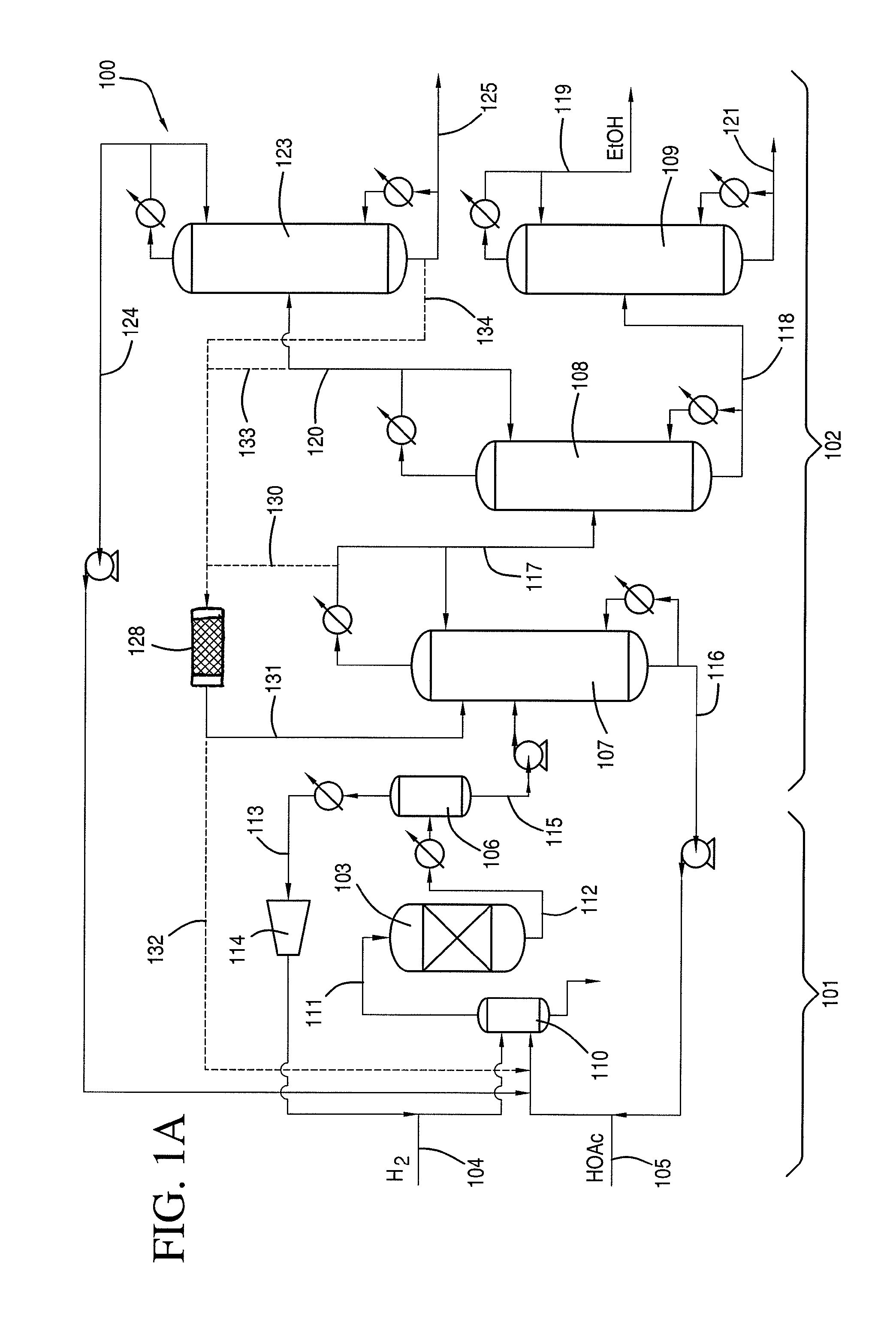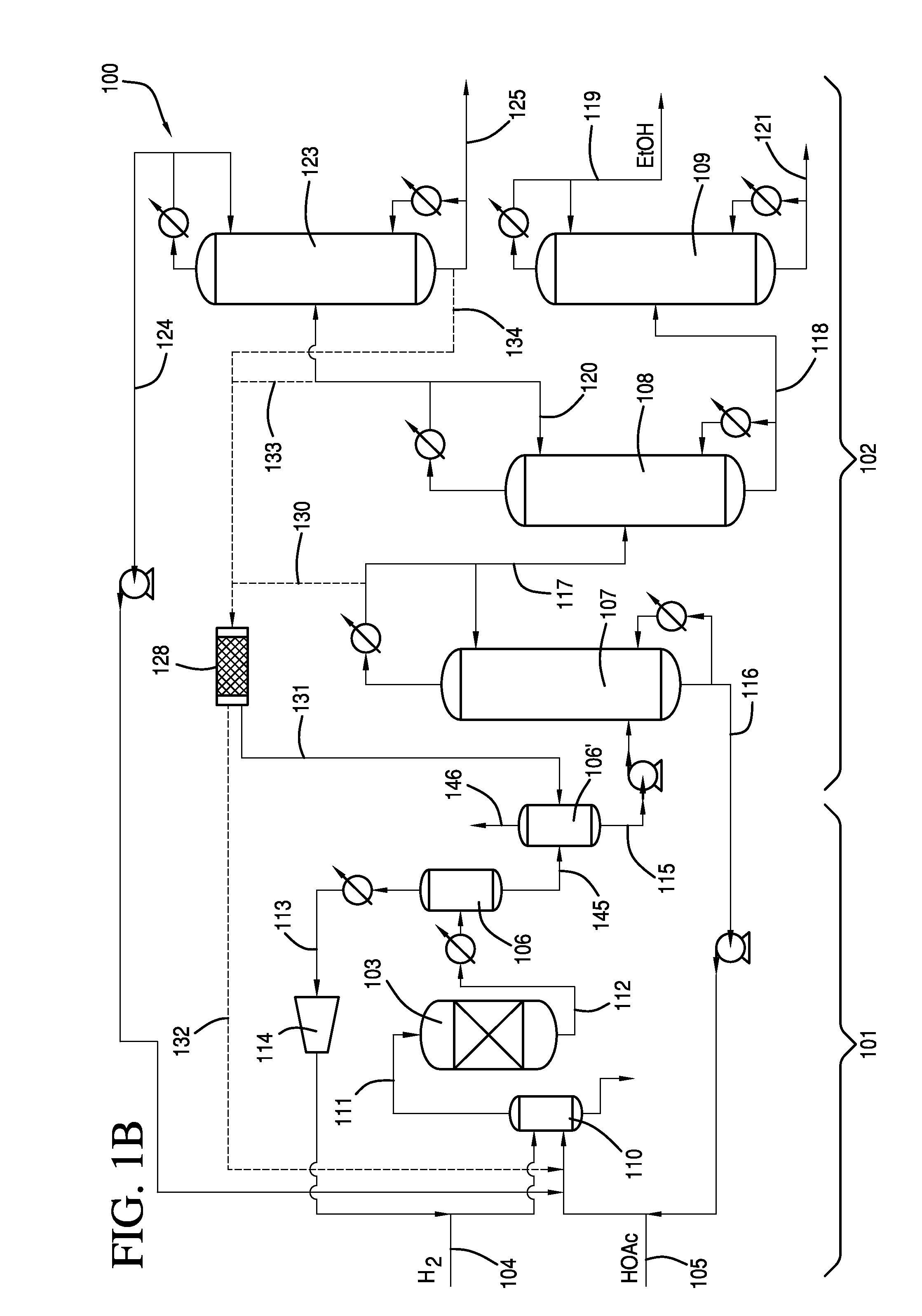Hydrolysis of ethyl acetate in ethanol separation process
a technology of ethanol and ethyl acetate, which is applied in the preparation of oxygen-containing compounds, purification/separation of oxygen compounds, organic chemistry, etc., can solve the problems of difficult separation, limited production and recovery of ethanol from such reaction mixtures, and unreacted acid remains in crude ethanol products
- Summary
- Abstract
- Description
- Claims
- Application Information
AI Technical Summary
Benefits of technology
Problems solved by technology
Method used
Image
Examples
example 1
[0109]Examples of flow rates / compositions, ethyl acetate hydrolysis, and hydrolysis reactor sizing based on the lab-scale distillation train preliminary material balance data are discussed as follows. A system as shown in FIG. 1A was used.
[0110]The first distillate was removed from column at 10.2 g / min. The fourth distillate was removed from column at 1.67 g / min A mixture comprising 10% (1.02 g / min.) of the first distillate from first column 107 and 50% (0.685 g / min.) of the fourth residue from fourth column 123 was fed to first column 107. The mixture had an initial H2O:EtOAc molar ratio of 2.56:1.0 with the potential for hydrolysis of 26.3% of the ethyl acetate contained in this mixture.
[0111]As shown in Table 8, the potential EtOAc hydrolysis described in this example would be equivalent to approximately a 10.6% reduction in the amount of EtOAc contained in the first column overhead (based on 0.199 g / min delta EtOAc via hydrolysis compared to a first column overhead EtOAc flow ra...
example 2
[0113]A crude ethanol product comprising ethanol, acetic acid, water and ethyl acetate was produced by reacting a vaporized feed comprising 95.2 wt. % acetic acid and 4.6 wt. % water with hydrogen in the presence of a catalyst comprising 1.6 wt. % platinum and 1 wt. % tin supported on ⅛ inch calcium silicate modified silica extrudates at an average temperature of 291° C., an outlet pressure of 2,063 KPa. Unreacted hydrogen was recycled back to the inlet of the reactor such that the total H2 / acetic acid molar ratio was 5.8 at a GHSV of 3,893 hr−1. Under these conditions, 42.8% of the acetic acid was converted, and the selectivity to ethanol was 87.1%, selectivity to ethyl acetate was 8.4%, and selectivity to acetaldehyde was 3.5%. The crude ethanol product was purified using a separation scheme having distillation columns as shown in FIG. 1.
[0114]The crude ethanol product was fed to the first column at a feed rate of 20 g / min. The composition of the liquid feed is provided in Table 9...
example 3
[0117]The first distillate of Example 2 was condensed and refluxed at a 1:1 ratio at the top of the first column, and a portion of the distillate was introduced to the second column at a feed rate of 7.6 g / min. The second column is a 2 inch diameter Oldershaw design equipped with 25 trays. The second column was operated at a temperature of 82° C. at atmospheric pressure. The column differential pressure between the trays in the second column was 2.6 KPa. The second residue was withdrawn at a flow rate of 5.8 g / min and directed to the third column. The second distillate was refluxed at a ratio of 4.5:0.5.
[0118]The hydrolysis potential of the second distillate of the second column is shown in Table 10.
TABLE 10Second100%50%10%DistillatepotentialpotentialpotentialDistillate(conc. wt %)(conc. wt %)(conc. wt %)(conc. wt %)Water7.23.44.46.2Acetic Acid0.036.34.61.6Ethanol11.716.515.212.9Ethyl Acetate79.870.673.977.5Others1.31.31.31.3
[0119]As shown in Table 10, the potential ethyl acetate hy...
PUM
| Property | Measurement | Unit |
|---|---|---|
| median pore diameter | aaaaa | aaaaa |
| packing density | aaaaa | aaaaa |
| packing density | aaaaa | aaaaa |
Abstract
Description
Claims
Application Information
 Login to View More
Login to View More - R&D
- Intellectual Property
- Life Sciences
- Materials
- Tech Scout
- Unparalleled Data Quality
- Higher Quality Content
- 60% Fewer Hallucinations
Browse by: Latest US Patents, China's latest patents, Technical Efficacy Thesaurus, Application Domain, Technology Topic, Popular Technical Reports.
© 2025 PatSnap. All rights reserved.Legal|Privacy policy|Modern Slavery Act Transparency Statement|Sitemap|About US| Contact US: help@patsnap.com



